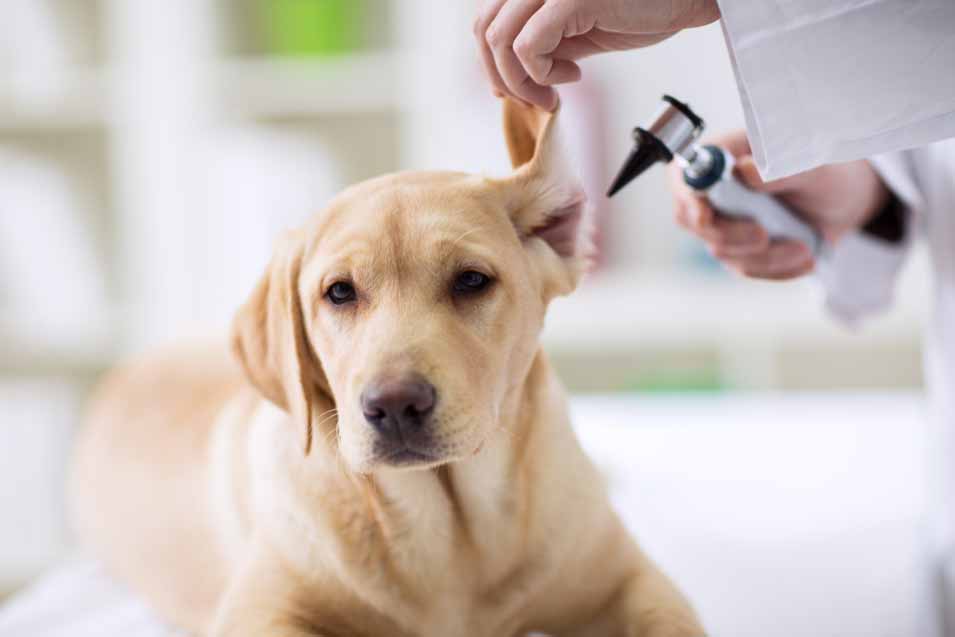Ear infections are one of the most common types of infections encountered in dogs. There are some breeds that are more predisposed to this health issue, and those that have large, hairy, and floppy ears are among them.
Some of these breeds are Miniature Poodles, Cocker Spaniels, as well as Old English Sheepdogs. The reason for this is that their ears don’t get enough ventilation, and the moist environment that’s created by the dog’s ear structure is perfect for the development of microorganisms. In this article, we’ll look at what clinical signs characterize auricular infections, how they can be treated, how you should apply the medication to your dog’s ears, and whether there are several natural remedies which you can use to prevent the issue from recurring.
Otitis Externa vs. Otitis Media and Interna
We won’t describe the anatomy of a dog’s ear to avoid making the matter too complicated. However, we’ll tell you that there are three types of ear infections that can be seen in dogs and they differ depending on the exact area that was affected. Otitis media is defined as the inflammation of the middle ear structures, otitis interna is what happens when the inner ear structures are affected, and as you might have guessed, otitis externa involves only the outer ear.
Otitis externa is by far the most common type of infection, and it occurs when the layer of cells which line the external ear canal suffer from inflammation. The vet can use an otoscope to make the difference between the three types of health problems.
Generally, cases of otitis media are caused by an extension of the infection affecting the external ear canal or by penetration of the eardrum by a particular foreign object. Inflammation of the middle ear can lead to the inflammation of the inner ear structures, therefore causing otitis interna. The latter is a serious medical issue as it can lead to deafness and loss of balance.
Symptoms of an Ear Infection
Signs of otitis externa:
- Headshaking
- Redness of the skin
- Odor
- Swelling
- Scratching
- Scaly skin
- Increased discharge
The signs of otitis media somewhat resemble those that characterize otitis externa, with the dog rubbing the affected ear on the floor, shaking his head or scratching the ear incessantly, or constantly rotating his head toward the affected side. The ear can be painful and could express discharge.
Otitis media can be diagnosed based on somewhat similar signs, but in this case, there is an addition of imbalance. To assess the presence of middle and inner ear infections, the dog will have to go through an otoscopic examination, and sometimes, even X-rays of the round bone behind the ear.
Fortunately, external ear infections are the most common ones, and they are also the easiest to treat of the three.
Causes
There are several factors that can be at the root of an ear infection. First of all, either one or both of the ears can be affected, and if only one is, for now, the infection could be spread to the other. Since dogs tend to scratch the ear, they can inadvertently transfer the pathogen onto the other paw and then to the other ear.
Some of the factors that directly cause the inflammation are represented by foreign objects, parasites, and allergies. On the other hand, bacteria, yeasts, as well as a middle ear infection can perpetuate the condition and make it a little more complicated to treat.
One can lead to another. For example, if the dog has contracted ear mites, they could create an environment where a secondary yeast or bacterial infection is developed. The same goes for foreign objects, which can effectively pierce through the skin, thereby causing an entryway for all sorts of microorganisms. Many of these germs are normally present in the ear environment, but they can be potentially pathogenic whenever they get the opportunity. A traumatic lesion effectively increases the chances of a dog to develop a bacterial or fungal infection.
Diagnosis
It’s important to note that just giving your dog medication won’t solve the problem as you aren’t aware of the extent of the infection or inflammation or the exact part of the ear that has been affected. Furthermore, without knowing the type of germ that has caused the infection, it’s impossible for you to give your dog the right treatment. Take your dog to the vet if you want him to be diagnosed and treated correctly.
Your dog might require anesthesia or sedation to allow a thorough examination with an otoscope. Some dogs have painful ears, and the ear canal is also obstructed with discharge, which makes the examination very difficult if the dog can’t sit still. Using an otoscope can determine whether there are any foreign objects deep in the ear, whether there are actual parasites that have caused low-grade infections, if there is debris present, and if the eardrum has been affected, as well.
Tissue cultures are often necessary to determine the infection-causing germs, and they can be taken at the same time that the examination of the ear canal with an otoscope is being performed. A smear can be taken with a cotton-tipped application, and microscopic examination of the smear can determine if bacterial overgrowth is present or just what type of germ is at the root of the problem. Sometimes, a bacterioscopic and bacteriologic exam is required, and to determine the exact type of medication to which the microbe responds, an antibiogram might also be necessary.
Ear discharge is very important. A dark one typically signals the presence of a parasite (such as eggs, larvae or adult ear mites) or a yeast infection. Other tests that can be performed depending on the type of disease that is suspected range from allergy testing to biopsies for animals that have obstructive, long-term inflammation of the external ear canal. X-rays can be taken, too, as they allow for better visualization of the eardrum.
Treatment of the Infection
The results of the otoscopic and microscopic exam determine the diagnosis and the right type of treatment. A wax plug, a parasite lodged in the ear canal, as well as a foreign body can be manually removed. However, most dogs will have to be sedated for this or just to allow an ear flushing or cleaning. Some dogs can have several types of infection present (a bacterial and a fungal one at the same time, two kinds of bacteria, or a parasitic and a bacterial infection). Naturally, this calls for the use of several medications or a broad-spectrum one.
There are dogs that suffer from hypothyroidism or allergies, and in that case, the underlying disease is suspected, diagnosed, and treated. Otherwise, Fido is going to continue experiencing chronic ear infections.
The vet will clean the dog’s ear properly and then will recommend using a topical medication. Keep in mind that the topical medication cannot get in contact with the ear wall if there is discharge or excessive earwax present in the ear canal. That’s why cleaning the ear is of utmost importance prior to applying the topical medication. In some situations, medication given by mouth or injection is included in the treatment, especially if the goal is to manage the health condition in the long run.
If the inflammation is severe, the dog might have to receive corticosteroid medication, along with the right antibiotic, antifungal, or antiparasitic treatment. For most cases of ear infections, the treatment lasts for as many as 2 to 4 weeks with weekly or bi-weekly physical examinations and tests until there’s no evidence of an infection whatsoever.
Natural Remedies for Dog Ear Infections
If your canine friend has had dog ear infections, you could use apple cider vinegar to clean his ears. However, the acetic acid in the vinegar shouldn’t be used if your dog already has red and painful ears. In fact, it can make the inflammation more severe. While it can remove dirt and debris from a dog’s ears, it shouldn’t ever be used on dogs that already have an ear infection.
Oregano oil is said to be effective, as well, but it should never be used undiluted as it can cause serious burns and irritations. Since it is a little more tricky to use, you might want to avoid it or you might want to create a very diluted solution using just one drop of the oil and half an ounce of pure aloe vera juice.
Calendula is a great natural remedy as it doesn’t have as many side effects as some of the other options you have available. The difference between using calendula and chamomile tea, for example, is that the latter can dry the ear wall too much. You can get calendula as an already made infused oil or you can use calendula tea to clean your dog’s ears if you know that he’s predisposed to auricular infections.
Last, but not least, coconut oil has both antifungal and antibacterial properties, making it a great product to clean your canine buddy’s ears with.
Prevention
The best way to prevent ear infections in dogs is to inspect his ears on a regular basis. Note any changes in skin color, increases in moisture, whether there’s any discharge, and even unusual temperature changes.
Frequently cleaning your dog’s ears (especially if you are the pet parent of a breed predisposed to ear pathologies, such as Cocker Spaniel, for example) is a safe way of preventing ear infections. However, this shouldn’t be done more than once or twice a week since doing so can mess with the normal microbes in the ear environment. If you were to remove the oil and wax in your dog’s ear too often, you’d effectively deplete the ear canal of its natural defense mechanism, making it vulnerable to yeast or other types of infections.
Since improving local ventilation and decreasing humidity in the ears is another goal here, you might also want to remove some of the hair around the ear canal. Talk to your vet before doing so, however, as this can be dangerous since it can also lead to inflammation.






